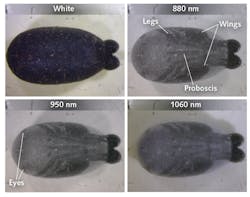Near-IR imaging reveals tsetse fly pupal development

Recognizing that the study of insect pupae from a larval state through emergence is an otherwise destructive process, researchers at the International Atomic Energy Agency (IAEA; Vienna, Austria) are using various wavelengths of near-infrared light to penetrate the protective pupal shell of tsetse and other flies to nondestructively image the details inside.
Using a simple microscope setup, the pupae were illuminated with four light-emitting diodes (LEDs) of a particular wavelength (equally spaced around the specimen in a circular stand) to compare imaging capabilities. The LED wavelengths selected were 880 nm (SFH 485-2 from Osram Opto Semiconductors in Regensburg, Germany), 950 nm (TSAL6100 from Vishay in Malvern, PA), 1060 nm (ELD-1060-525 from EPIGAP Optronic in Berlin, Germany), and white LEDs (LTW-2S3D8 from Lite-On in Milpitas, CA). Driven from a 7.5 V power supply at 95 mA for the three near-IR LEDs and 30 mA for the white LEDs, the LED illumination experiments revealed the internal structures of developing pupae. In particular, the 1060 nm LED illumination was suitable to show differences in pupae wing structure that indicate tsetse fly gender—a valuable capability that allows sex sorting of developing pupae for agricultural studies and applications that would not otherwise be possible using destructive analysis methods. Reference: Z. R. Moran and A. G. Parker, J. Insect Sci., 16, 1, 1–9 (2016).
About the Author

Gail Overton
Senior Editor (2004-2020)
Gail has more than 30 years of engineering, marketing, product management, and editorial experience in the photonics and optical communications industry. Before joining the staff at Laser Focus World in 2004, she held many product management and product marketing roles in the fiber-optics industry, most notably at Hughes (El Segundo, CA), GTE Labs (Waltham, MA), Corning (Corning, NY), Photon Kinetics (Beaverton, OR), and Newport Corporation (Irvine, CA). During her marketing career, Gail published articles in WDM Solutions and Sensors magazine and traveled internationally to conduct product and sales training. Gail received her BS degree in physics, with an emphasis in optics, from San Diego State University in San Diego, CA in May 1986.